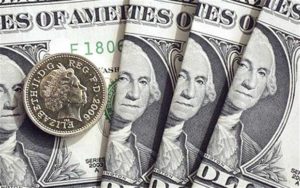 Yesterday’s trade saw GBP/USD within the range of 1.4198-1.4346. The pair closed at 1.4261, edging up 0.20% on a daily basis. It has been the 33rd gain in the past 72 trading days and also a third consecutive one. The daily high has been the highest level since April 1st, when a high of 1.4379 was registered. GBP/USD has trimmed its slump to 0.79% so far during the current month, following a 3.20% surge in March.
Yesterday’s trade saw GBP/USD within the range of 1.4198-1.4346. The pair closed at 1.4261, edging up 0.20% on a daily basis. It has been the 33rd gain in the past 72 trading days and also a third consecutive one. The daily high has been the highest level since April 1st, when a high of 1.4379 was registered. GBP/USD has trimmed its slump to 0.79% so far during the current month, following a 3.20% surge in March.
At 6:25 GMT today GBP/USD was inching down 0.04% for the day to trade at 1.4255. The pair touched a daily low at 1.4236 at 5:54 GMT, undershooting the daily S2 level, and a daily high at 1.4280 during the early phase of the Asian trading session.
On Wednesday GBP/USD trading may be influenced by the following macroeconomic reports as listed below.
Fundamentals
United Kingdom
Bank of England Credit Conditions Survey
At 8:30 GMT the Bank of England (BoE) will publish its report on lending conditions in the United Kingdom during the three months to March. It is based on a survey of banking and non-banking institutions, which provide information regarding secured and not secured loans to households, small and medium enterprises and corporations outside financial sector. Respondents in the survey are asked about their opinion on conditions during both past three and the upcoming three months.
United States
Retail Sales
Retail sales in the United States probably rebounded in March, going up at a monthly rate of 0.4%, according to the median forecast by experts. In February retail sales went down 0.1% to mark their second consecutive month of decline.
Among the 13 major categories, 5 registered growth, while 8 showed declines in February. During the period, an increase in sales was reported at building material, garden equipment and supplies dealers (+1.6% month-over-month), sporting goods, hobby, book and music stores supplies dealers (+1.2%), food services and drinking places (+1%), clothing (+0.9%) and health and personal care stores (+0.7%).
On the other hand, in February, retail sales dropped at gasoline stations (-4.4%), miscellaneous store retailers (-1.1%), furniture and home furniture (-0.5%), motor vehicle sales and part dealers (-0.2%), food and beverages (-0.2%), general merchandise stores (-0.2%), non-store retailers (-0.2%) and electronics and appliance stores (-0.1%), according to the report by the US Census Bureau.
Annualized retail sales surged 3.1% in February, following a 3.4% climb in January.
US core retail sales, or retail sales ex autos, probably increased 0.5% in March compared to a month ago, following a 0.1% drop in February. If so, March would be the fastest rate of increase in core sales since July 2015, when a revised up 0.6% surge was reported. This indicator removes large ticket prices and historical seasonality of automobile sales.
In case the general index of sales rose more than anticipated in March, this would have a strong bullish effect on the US dollar, because of positive implications regarding consumer spending and consumer inflation in the country. The official report is due out at 12:30 GMT.
Producer Prices
Annual producer prices in the United States probably rose for the first time in the past 14 months in March, by 0.3%, according to the median estimate by experts. In February producer prices remained flat. The Producer Price Index reflects the change in prices of over 8 000 products, sold by manufacturers during the respective period. The PPI differs from the Consumer Price Index (CPI), which measures the change in prices from consumer’s perspective, due to subsidies, taxes and distribution costs of different types of manufacturers in the country. In case producers are forced to pay more for goods and services, they are more likely to pass these higher costs to the end consumer. Therefore, the PPI is considered as a leading indicator of consumer inflation. In case annual producer prices rose at a faster rate than anticipated, this would have a moderate bullish effect on the US dollar.
The nation’s annualized core producer price inflation, which excludes prices of volatile categories such as food and energy, probably decelerated to 1.1% in March from 1.2% in February. The latter has been the fastest annual surge in the core PPI since January 2015. The Bureau of Labor Statistics is expected to report on the official PPI performance at 12:30 GMT.
Federal Reserves ”Beige Book” report
At 18:00 GMT the Federal Reserve is to release its ”Beige Book” report. It is published eight times during the year. Each of the banks in the 12 Federal Reserve Districts gathers data in regard to current economic situation in the country on the basis of interviews with key business contacts, economists, market experts, and other sources. In case the Beige Book presents an optimistic economic outlook, this will usually support the greenback, while a pessimistic view will have a bearish effect on the currency.
Daily and Weekly Pivot Levels
By employing the Camarilla calculation method, the daily pivot levels for GBP/USD are presented as follows:
R1 – 1.4275
R2 – 1.4288
R3 (range resistance) – 1.4302
R4 (range breakout) – 1.4342
S1 – 1.4247
S2 – 1.4234
S3 (range support) – 1.4220
S4 (range breakout) – 1.4180
By using the traditional method of calculation, the weekly pivot levels for GBP/USD are presented as follows:
Central Pivot Point – 1.4151
R1 – 1.4295
R2 – 1.4466
R3 – 1.4610
S1 – 1.3980
S2 – 1.3836
S3 – 1.3665





